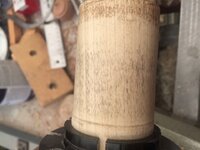Spinzwood
Member
I was watching a few YouTube videos where turners made their own sanding wax. Essentially, the formula was 4 parts mineral oil, 1 part tripoli and one part beeswax. I did this by weight. 6 oz, 1.5 oz and 1.5 oz.
Formulation was easy.. but, I got horrible results in my one trial on a light colored piece of alder (I think it was alder). Anyhow as you can see in the photo, the sanding wax left dark gray color in the wood.. not what I was expecting.
The guys that made the SW on YouTube had a tan colored tripoli and mine was a dark gray color. I ordered it from Amazon and it was listed as Rottonstone/Tripoli. It was made by Behlens which I remember as a reputable manufacturer of wood finishing products and was listed on the container for finishing woodwork that has a finish applied.. such as a varnish.
So, not what I expected.. Have any of you made your own sanding wax? If so, what did you use for the grit?
Thanks
Edit: I later saw a formulation by Capt'n Eddie. He used beeswax and mineral oil without the tripoli. I'm guessing this is likely what I should make up. Probably use the mix with the rottenstone for putting a polish on items that have already had a hard finish applied. Wonder if it would work with acrylics.. which I have yet to try..
Formulation was easy.. but, I got horrible results in my one trial on a light colored piece of alder (I think it was alder). Anyhow as you can see in the photo, the sanding wax left dark gray color in the wood.. not what I was expecting.
The guys that made the SW on YouTube had a tan colored tripoli and mine was a dark gray color. I ordered it from Amazon and it was listed as Rottonstone/Tripoli. It was made by Behlens which I remember as a reputable manufacturer of wood finishing products and was listed on the container for finishing woodwork that has a finish applied.. such as a varnish.
So, not what I expected.. Have any of you made your own sanding wax? If so, what did you use for the grit?
Thanks
Edit: I later saw a formulation by Capt'n Eddie. He used beeswax and mineral oil without the tripoli. I'm guessing this is likely what I should make up. Probably use the mix with the rottenstone for putting a polish on items that have already had a hard finish applied. Wonder if it would work with acrylics.. which I have yet to try..
Attachments
Last edited:

